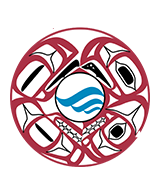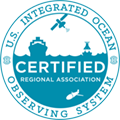Scientists use a number of different methods to collect data depending upon the data they need, the location they're sampling, and the available platforms. The long-term data collected from buoy sensors, shore stations, or HF radar can be used in computer models that simulate the ocean environment. Here are many of the methods scientists use to collect data:
Ocean Observing has become a system for observations, modeling and analysis of marine and ocean parameters that support operational ocean activities such as fisheries, recreational boating, natural hazards warnings, search and rescue operations, and marine operations, as well as scientific inquiry. Through an ocean observing system these diverse user groups can receive accurate descriptions of the present state of the oceans including living resources, continuous forecasts of future sea conditions, and forecast indicators for climate change.
A Coastal Ocean Observing System is designed to produce and disseminate ocean observations and related products in a common format and according to sound scientific practice. The Coastal Ocean encompasses the region from the head of the tide to the seaward boundary of the Exclusive Economic Zone or EEZ, which is a seazone where states have special rights over the exploration and use of marine resources.
Coastal regions including the Great Lakes form a partnership that's linked to users via an interactive flow of data and information, which is first measured and transmitted, then organized, cataloged, and disseminated, and finally translated into products that meet users' needs and requirements. A management oversight system insures the continued and routine flow of data and information as well as the ongoing adaptation to user groups with the development of new technologies.
Platforms
Buoys
Floating buoys are anchored to the ocean floor and hold many sensors that measure both air and water conditions. Common sensors found on a buoy that measures air conditions include: barometric pressure, wind direction, wind speed and gust, and air temperature. Sensors that measure water conditions are located on the buoy at the surface of the water as well as suspended from the buoy down into the water column. These sensors can measure conditions including: wave height, wave period, direction of wave propagation, currents speed and direction, water temperature, salinity, turbidity, chlorophyll, nutrients, pH, and dissolved oxygen. Buoys typically get their power from a solar panel attached to the float, and they transmit their data at regular intervals through satellites.
HF Radar
The speed and direction of ocean surface currents can be determined using data collected from high-frequency (HF) radar. Radio signals are sent out from land-based radio antennae to bounce off the ocean's waves. How these radar signals reflect off the waves and are received back by radar antennae enable researchers to determine the speed and direction that surface water is moving. This information is displayed as surface currents maps.
Meteorological Stations
Meteorological stations measure atmospheric conditions, including air temperature, wind speed, wind direction, relative humidity, barometric pressure, solar radiation, and rainfall. These stations are located in many places like the tops of buildings, at airports, lighthouses, and schools.
Shore Stations
Instruments / sensors placed on piers, docks, pilings, and jetties measure water conditions, such as temperature, salinity, chlorophyll, turbidity, and water level.
Research Vessels
Scientists onboard research vessels conduct research cruises to gather physical, chemical and biological information on ocean conditions along the cruise route. Some sensors are mounted on the ship and take regular measurements of water and atmospheric conditions. Researchers also deploy other instruments to gather information on conditions throughout the water column. Water samples and samples of organisms caught via nets are brought onboard for further testing and analysis.
Vessels of Opportunity
Many ships at sea including cargo ships, tankers, ferries and cruise boats have sensors that measure atmospheric and water conditions including temperature, salinity, wind speed and direction, precipitation, and currents speed / direction.
Satellites
Satellites can measure ocean conditions including sea surface temperature, ocean color, and sea surface height. Satellites are orbiting the Earth at an altitude of 500 to over 20,000 miles high, passing over the Pacific Northwest many times a day.
Autonomous Underwater Vehicles (AUVs)
AUVs are small, free-swimming underwater vessels often used for research. Some AUVs use density and wings for forward motion, whereas others use propellers and rudders. Seagliders (SG) (shown here) contain a battery pack that moves fore and aft to change the glider's pitch, and then rotates, causing SG to roll, which produces a turn. An external bladder inflates and deflates causing a change in buoyancy. SGs can gather conductivity-temperature-depth (CTD) data from the ocean for months at a time and transmit it to shore in near-real time via satellite data telemetry. AUVs greatly reduce risk and costly ship time since they can be packed with sensors and are able to easily sample the entire water column.
Animals
Scientists attach satellite tags on animals such as sharks, whales, seals, and sea turtles. These sensors can record data such as the animal's position, depth, and the surrounding water's salinity and temperature. Transmitted back via satellite, this valuable data can help researchers understand the animals' migratory routes and habitat. Such data can be used to protect endangered species like the Leatherback Turtle, Black-footed Albatross, and Blue Whale, plus better manage fisheries such as Bluefin Tuna, Yellowfin Tuna, and Swordfish.
| National Observing System Partners Alliance for Coastal Technologies (ACT) Southeastern Universities Research Association (SURA) Integrated Ocean Observing System IOOS | |||||||

